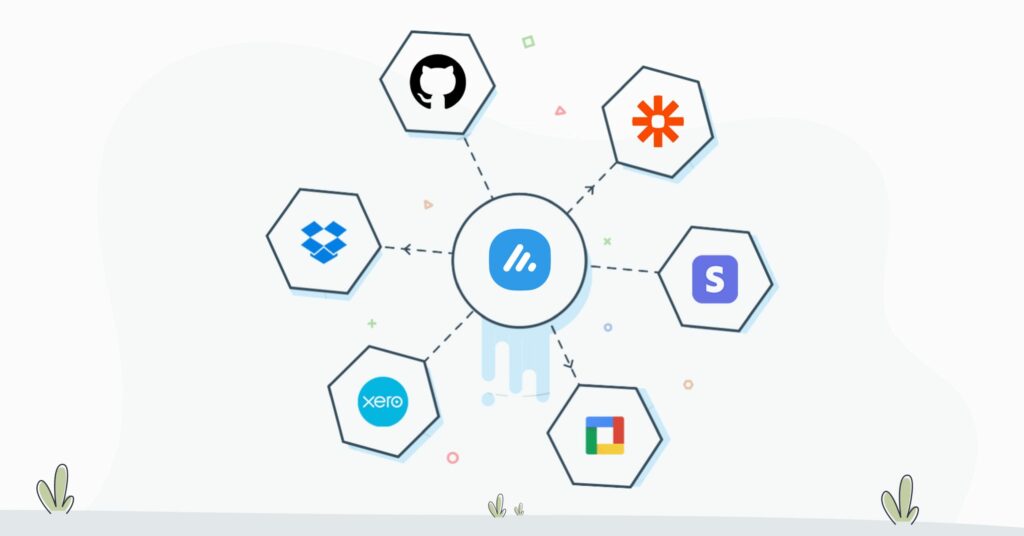So you have browsed the features, gotten a demo and are convinced Avaza is the right tool for your workplace needs. But what’s next?
Avaza’s value, as an all in one professional automation tool, is best leveraged if adopted to work the way your workplace needs it to work. We aspire to cover your work management needs so you can thrive and grow. But as a new customer, this journey often requires “management of change” within your organization, in order for your team to adopt Avaza and make the most of its features and capabilities.
Helping your team adopt Avaza will involve transitioning from a different way of work or the switch from one or a set of different tools. And guess what, people often resist change! You can expect some reluctance, some feet dragging and some setbacks and delays as your team gets the hang of things.
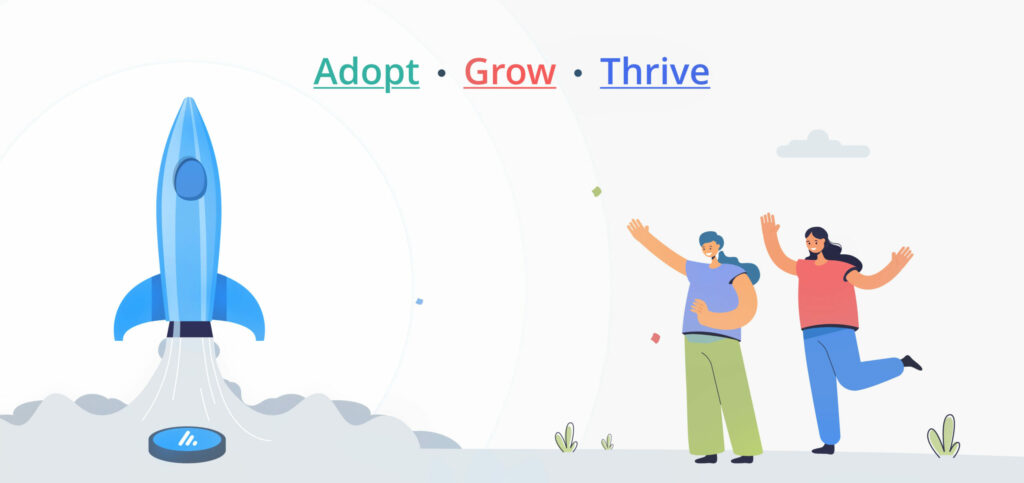
This team onboarding guide is designed for managers to proactively lead this change and minimize the pitfalls of transition. It leverages the expertise of our customer success managers who have worked with thousands of customers across the globe to understand their needs and pain points. It uses the well-established principles of change management, coupled with Avaza’s recommended best practices based on functionality, to give your business the best start in adopting, growing and thriving with Avaza.
Get Started
We recommend importing the Avaza Onboarding Project onto your own Avaza account. This project contains a handy list of tasks, broken down into sections and types of users, each targeting a specific Avaza function/module to make it easier for your team to get started.
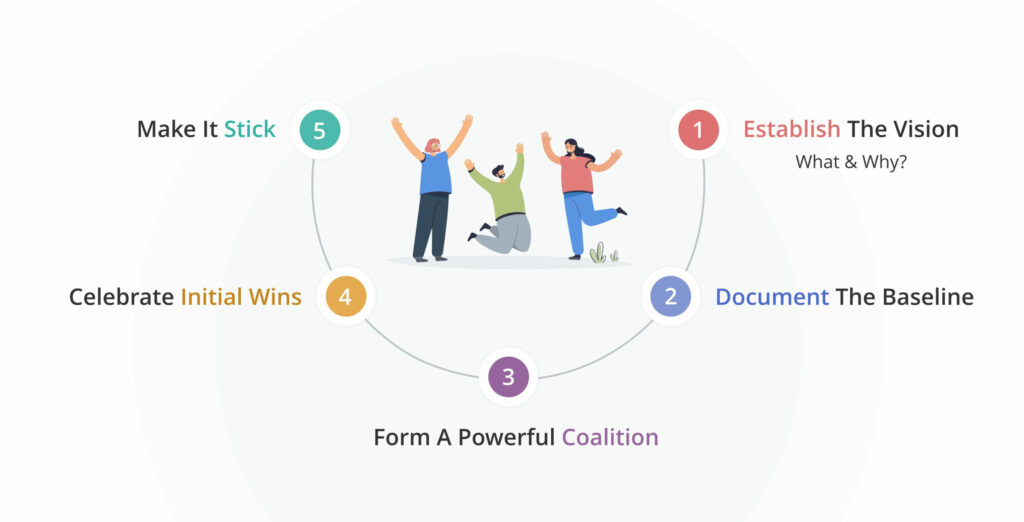
Follow these steps to manage the process of getting your team to adopt Avaza.
1- Create a Vision (Identify WHAT you want to achieve and WHY)
Prior to rolling out a new solution, it’s important to think about how Avaza can help your team achieve its objectives and address existing workflow challenges or generally simplify how things are done.
Formulate a concise statement about why Avaza is being adopted by your team and organization. What will it do to improve things? What problems do you wish to solve with its help?
For this it’s useful to make a list of pain points that you and your team have been facing, for instance:

Fragmented Communication: Teams often struggle with disjointed communication channels leading to information silos, lost messages, and disjointed workflows.

Inefficient Time Tracking: Manual time tracking is prone to errors and inefficiencies, making it difficult to accurately bill clients and pay contractors

Project Overruns and Scope Creep: Without proper monitoring, projects can frequently exceed budgets and timelines, or expand beyond their original scope without appropriate adjustments or client billing.

Complex Resource Management: Allocating the right resources to the right tasks can be challenging, often leading to either overworked or underutilized team members.

Lack of Real-Time Project Visibility: We find it hard to get an up-to-the-minute view of project progress, which hampers the ability to make informed decisions promptly.

Difficulties in Managing Remote Teams: Coordinating and collaborating with team members who work remotely can be problematic due to lack of shared physical space and time zone differences.

Inconsistent Project Methodologies: Teams may use a mix of project management styles and tools, leading to inconsistency and confusion in project delivery.

Clunky Expense Reporting: Managing receipts and expense reports is often cumbersome and time-consuming, resulting in delayed reimbursements and financial reporting headaches.

Billing and Invoicing Inefficiencies: Creating, sending, and following up on invoices can be an arduous and error-prone process, affecting cash flow and client satisfaction.

Client Collaboration Issues: Engaging clients in the project process can be difficult without a streamlined way to share updates, gather feedback, and maintain transparency.

Data Security Concerns: Ensuring the security and privacy of project data is increasingly challenging, especially with the rise of cyber threats and the complexity of compliance with various data protection regulations.

Unwieldy Reporting Systems: Generating meaningful and actionable reports from disparate data sources can be time-consuming and often requires manual intervention to piece together comprehensive insights.

Challenging Integration with Other Tools: Agencies typically use a variety of tools, and lack of integration among them can lead to repetitive data entry and reduced operational efficiency.
Sample Avaza Vision Statement:
“[Team/Organization name] uses Avaza to manage [these projects and processes] to alleviate [these pain points] so that we can accomplish [these goals].”
This statement can be used to create a sense of urgency for bringing about the desired change. It should be communicated often and on multiple team communication channels.
For example:
At ThoughtBubble, we aim to use Avaza to create a collaborative workspace that fosters innovation and efficiency. We want to streamline project management, time tracking, expense reporting, and financial processes into a user-friendly interface, removing complexities that slow us down.
Or
At Lawgic, we are adopting Avaza to easily put together project estimates and invoices for services as well as assign tasks with deadlines so we can complete projects and conveniently bill clients to get paid on time.
We are committed to:

Fostering Transparency: By adopting Avaza, we aim to create an environment where every team member is informed, engaged, and proactive, understanding their role in the larger context of our collective success.

Enhancing Productivity: We intend to maximize our team’s productivity by streamlining workflows, reducing the time spent on administrative tasks, and focusing more on the work that truly matters.

Delivering Excellence: Through Avaza’s robust project management tools, we strive to exceed client expectations with stellar project delivery, ensuring every deadline is met with quality results.
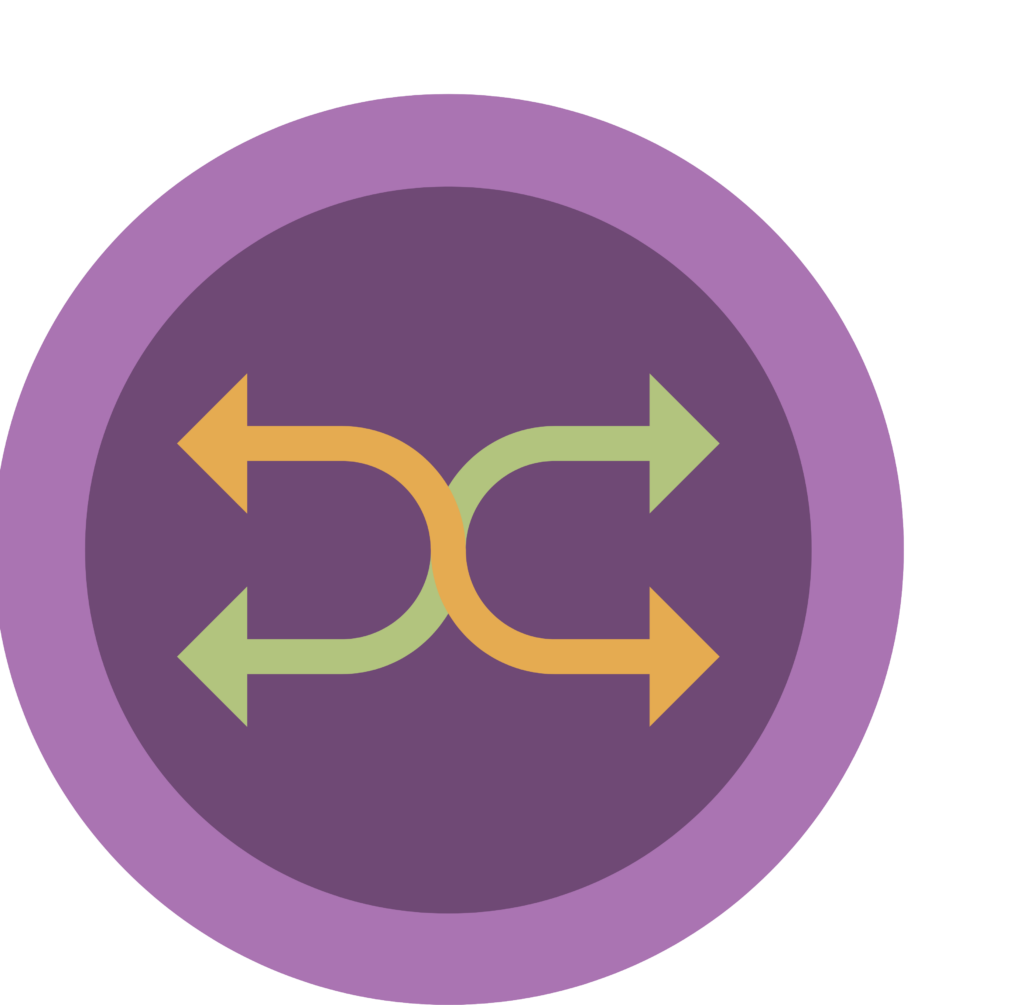
Promoting Flexibility: With Avaza, we want to provide our team with the flexibility to work from anywhere, at any time, while maintaining cohesion and synchrony in our collaborative efforts.

Driving Growth: By utilizing Avaza’s comprehensive reporting and financial tools, we aim to make informed decisions that drive profitability and sustainable growth.

Enhancing Decision-Making: Leveraging Avaza’s data-centric approach, we aspire to gain actionable insights that inform strategic decision-making and promote a culture of continuous improvement.
We believe that with Avaza as our operational backbone, we will not only achieve our project management goals but also create a dynamic and responsive business that is equipped to thrive in a competitive landscape. Through Avaza, we will transform the way we work, elevating our team’s potential to reach new heights of success and customer satisfaction.
2. Document the Baseline
Before implementing Avaza, conduct a comprehensive internal review to understand your team’s current workflow processes. This step involves identifying and documenting how your team tackles the tasks and challenges outlined previously. You’ll want to pay particular attention to the duration of these processes and pinpoint where bottlenecks and inefficiencies occur—these are the areas Avaza is expected to improve.
To accurately measure the effectiveness of Avaza post-implementation, it’s essential to have a clear picture of the present situation. This baseline will serve as a benchmark against which you can compare future performance metrics. Several months after Avaza has been integrated into your daily operations, you’ll be able to conduct a before-and-after analysis, quantifying the tool’s impact on your team’s efficiency and productivity.
In addition to process documentation, assess how Avaza will complement and integrate with your existing technology stack. This evaluation will help you understand the adjustments needed for a seamless transition to using Avaza and ensure that it synergizes well with the tools your team is already using. By taking this preparatory step, you’ll set a foundation for a smooth adoption of Avaza and position your team to leverage its full range of capabilities.
3. Establishing a Strategic Adoption Team
To ensure the successful implementation of Avaza within your organization, it’s crucial to form a dedicated coalition of influential team members. This group, referred to as “Power Users,” will be instrumental in driving the adoption process from the ground up. Here’s how to go about forming this pivotal team:
- Selection of Power Users:
Carefully select a group of Power Users from across your organization. These individuals should not only be adept at grasping new technology but also possess the enthusiasm and influence to encourage others. They will serve as the pioneers of Avaza within your team, showcasing its benefits and leading by example. - Collaboration with Onboarding Specialists:
Once identified, these Power Users will collaborate closely with an Avaza onboarding specialist. Their first task will be to outline a comprehensive timeline for team onboarding. This timeline will factor in all critical milestones, from initial setup to full-scale adoption. - Defining Onboarding Requirements:
With the onboarding specialist, the Power Users will delineate the functional requirements — which features of Avaza are most relevant to your workflows and how they should be configured to meet your business needs. Training requirements will also be specified, determining what training materials are needed, which formats will be most effective, and how to address different learning styles within your team. - Influencing Regular Users:
It’s imperative to recognize that for any organizational change to be enduring, it must permeate through all levels of the team. Power Users will act as the bridge between the new system and Regular Users, who are the wider group of employees that will use Avaza for their daily tasks. By leveraging their positions as middle managers or informal leaders, Power Users can effectively influence Regular Users and facilitate a smooth transition. - Leadership and Allyship:
As the manager spearheading this change, you should position yourself as a visionary leader who is closely aligned with these Power Users. Your leadership is vital for setting the tone for the change and for ensuring that the implementation of Avaza is seen not just as a new tool but as a strategic enhancement to how the organization operates.
By following these steps, you can establish a powerful coalition within your organization that will not only drive the adoption of Avaza but also foster an environment of continuous improvement and innovation.
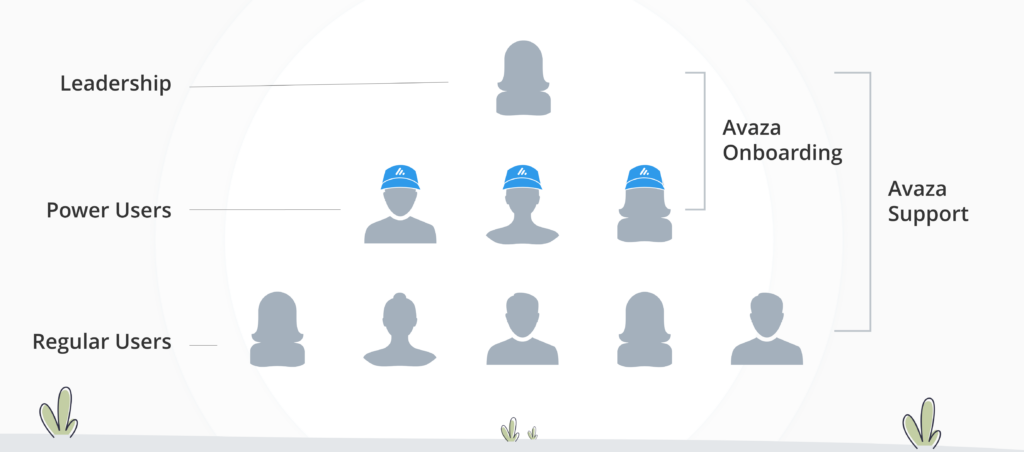
Hierarchy of Leadership, Power User, Regular User, with Avaza Onboarding and Support on the side
4. Facilitating Proactive Engagement and Transition to Avaza
To initiate active use of Avaza within your organization, begin by organizing a comprehensive introductory session, commonly known as a “kickoff meeting.” This gathering is an opportunity to familiarize your entire team with Avaza and to strategically communicate its benefits. Below is a detailed approach to conducting this phase:
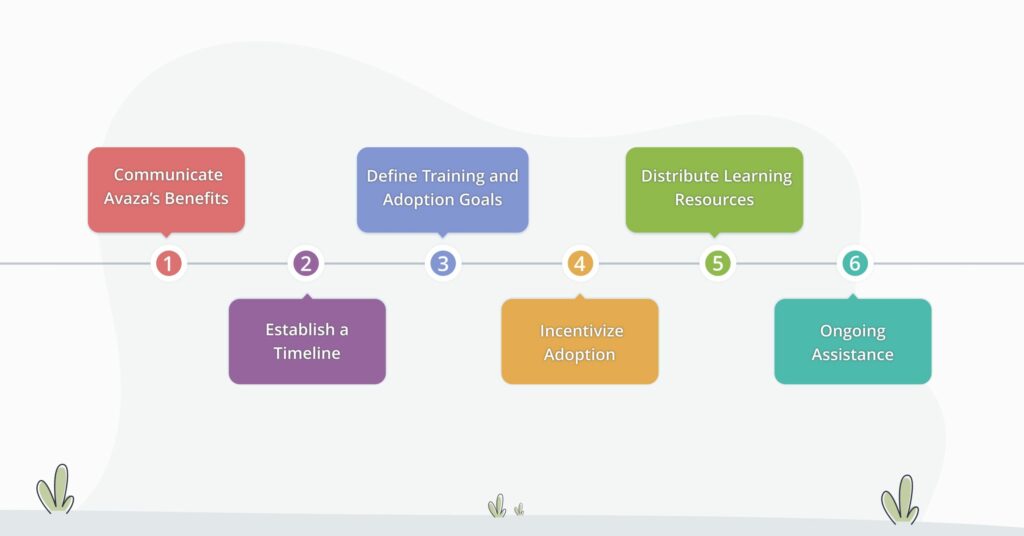
- Hosting the Kickoff Meeting:
Arrange a date for the entire team to come together for the kickoff meeting. This event is pivotal in building enthusiasm and conveying the strategic importance of adopting Avaza. - Communicating Avaza’s Benefits:
During the kickoff meeting, highlight the key features of Avaza and explain how it aligns with your team’s objectives. Focus on the ways Avaza will streamline workflows, improve efficiency, and simplify daily operations. - Establishing a Timeline:
Clearly set a “go-live” date for when the team is expected to start using Avaza. Outline a transition plan from any current tools to Avaza. For example, “We will complete the transition from Tool X to Avaza by [specific date], which is projected to save [X amount of time] by centralizing our processes on a single platform.” - Defining Training and Adoption Goals:
Communicate the expectations for learning and adoption, such as: “Within seven days of our initial training, all team members will be expected to use Avaza for all relevant tasks.”
- Incentivizing and Supporting Adoption:
Implement a system of rewards for those who actively engage with and adopt Avaza. Simultaneously, provide robust support for any team members who may be hesitant, ensuring they have the resources and assistance needed to transition confidently.
- Ongoing Assistance from Avaza Experts:
Utilize the expertise of your in-house Avaza specialists to provide ongoing support, onboarding assistance, and tailored training sessions. Consider structuring separate training sessions for Power Users, who may require a deeper understanding of the platform’s advanced features, and Regular Users, who may need to focus on the day-to-day functionalities.
- Leveraging the Avaza Kickoff Deck:
Make use of available resources like the Avaza Kickoff Deck Meeting Template to structure your introductory session effectively and to ensure all pertinent points are covered. - Distributing Learning Resources:
Share the following “getting started” resources with your team members, scheduling times that align with the go-live date:
- Getting Started with Project Management (20 minutes)
- Getting Started with Timesheets (15 minutes)
- Getting Started with Expenses (15 minutes)
- Getting Started with Estimates (10 minutes)
- Getting Started with Invoices (10 minutes)
- Schedule Your Team (5 minutes)
- Getting Started with Chat (5 minutes)
- Arranging Live Training Sessions:
Offer the opportunity to book a 30-minute training session with a live Avaza trainer, allowing team members to ask questions and interact with the tool under the guidance of an expert.
By taking these steps, you’ll ensure that your team is not only well-informed about the benefits and functionalities of Avaza but is also empowered to take full advantage of the platform to enhance productivity and collaboration.
5. Strengthening and Refining the Change Process
As your organization transitions to Avaza, it’s crucial to monitor and reinforce the change continually. Here’s how to deepen the adoption and utilization of Avaza across your teams:

- Celebrating Incremental Successes:
With each small victory, take the time to analyze and understand what aspects of Avaza are being used successfully and what areas require improvement. Public recognition of small successes can serve as powerful motivation for your team. - Conducting Regular Check-Ins:
Schedule frequent discussions with both Power Users and Regular Users, particularly in the early phases of Avaza’s implementation. These sessions are vital for troubleshooting issues promptly, ensuring that any problems are resolved quickly to maintain high levels of user adoption and satisfaction. - Leveraging Avaza Conventions:
Become familiar with and adhere to the best practices and standard conventions of using Avaza. Rely on the experience and knowledge of your onboarding partners to guide you in this area. They will help you understand the intricacies of Avaza and ensure you are using the platform as effectively as possible.
- Creating a Reference Guide:
Develop an internal guide based on Avaza’s conventions for your team. This document should serve as the go-to reference for establishing and maintaining team norms and protocols within Avaza, ensuring consistency in usage.
- Fostering a Learning Environment:
Encourage an atmosphere where mistakes made during the learning process are accepted as part of the journey. Everyone should feel comfortable experimenting with the platform to fully understand its capabilities.
- Role of Power Users in Guidance:
Power Users play a crucial role in guiding and redirecting team members back to the established Avaza usage conventions. They should provide constructive feedback and assist others in navigating the tool effectively, especially when deviations from standard practices are noticed.
- Iterative Improvement and Feedback Loops:
Implement a feedback loop where users can report back on their experience with Avaza, suggest improvements, and identify features that may be underutilized or misunderstood. This continuous loop of feedback and adjustment is essential for evolving the usage of Avaza to best suit your team’s needs.
By taking these comprehensive steps, you ensure that the change isn’t merely implemented but is built upon. This dynamic approach allows your organization to continuously refine its processes and maximize the benefits derived from Avaza.
6. Evaluating Progress and Advancing Usage
To effectively gauge the impact of Avaza on your business operations, a detailed analysis after a considerable period of usage, such as one to two months, is critical. This process will involve a series of evaluative measures and strategic expansions as outlined below:

- Reflection and Comparison:
Revisit the vision statement crafted at the beginning of this journey to refocus on the intended objectives of adopting Avaza. Compare the current state of operations with the baseline data collected during the initial assessment phase to measure progress. - Engaging with Your Team:
Conduct a comprehensive survey or a series of interviews with your team to gather their feedback on the Avaza experience. Key questions to ask include:- Have we achieved the goals set out in our original vision statement?
- Are the new processes facilitated by Avaza running more efficiently than before?
- What is the time difference in completing similar tasks now as opposed to before Avaza’s implementation?
- How does Avaza’s effectiveness measure up against our initial expectations, and has it addressed the issues we intended it to solve?
- Assessing and Sharing Success:
Upon identifying areas of success, openly share this progress with your team members, executive sponsors, and other stakeholders. Highlight how Avaza has positively influenced workflows, efficiency, and overall team performance. This recognition can serve as a catalyst for continued improvement and buy-in. - Scaling Avaza’s Usage:
If the initial implementation has proven successful, consider scaling up Avaza’s usage by incorporating additional processes, projects, and workflows into the platform. Gradually expand Avaza’s footprint within your organization to leverage its full potential.
- Incorporating Avaza into Organizational Culture:
For sustainable success, integrate the principles and objectives of your Avaza adoption into the core values of your organization. Encourage all employees to align with this vision, reinforcing the importance of streamlined workflows and collaboration that Avaza promotes.
- Continual Reassessment and Adaptation:
Establish a regular review schedule to reassess the effectiveness of Avaza within your organization. Be prepared to adapt and make changes to your approach to ensure that Avaza continues to meet the evolving needs of your business.
By meticulously following these steps, you can not only quantify the benefits of Avaza but also reinforce and broaden its use within your organization, ensuring that Avaza remains an integral part of your operational infrastructure.

